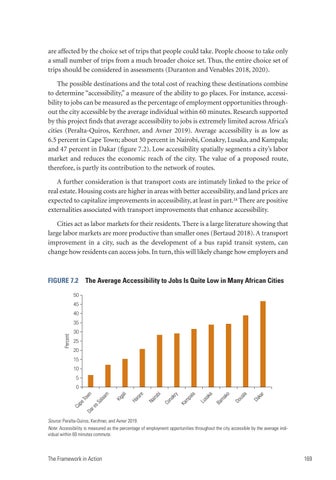are affected by the choice set of trips that people could take. People choose to take only a small number of trips from a much broader choice set. Thus, the entire choice set of trips should be considered in assessments (Duranton and Venables 2018, 2020). The possible destinations and the total cost of reaching these destinations combine to determine “accessibility,” a measure of the ability to go places. For instance, accessibility to jobs can be measured as the percentage of employment opportunities throughout the city accessible by the average individual within 60 minutes. Research supported by this project finds that average accessibility to jobs is extremely limited across Africa’s cities (Peralta-Quiros, Kerzhner, and Avner 2019). Average accessibility is as low as 6.5 percent in Cape Town; about 30 percent in Nairobi, Conakry, Lusaka, and Kampala; and 47 percent in Dakar (figure 7.2). Low accessibility spatially segments a city’s labor market and reduces the economic reach of the city. The value of a proposed route, therefore, is partly its contribution to the network of routes. A further consideration is that transport costs are intimately linked to the price of real estate. Housing costs are higher in areas with better accessibility, and land prices are expected to capitalize improvements in accessibility, at least in part.14 There are positive externalities associated with transport improvements that enhance accessibility. Cities act as labor markets for their residents. There is a large literature showing that large labor markets are more productive than smaller ones (Bertaud 2018). A transport improvement in a city, such as the development of a bus rapid transit system, can change how residents can access jobs. In turn, this will likely change how employers and
FIGURE 7.2
The Average Accessibility to Jobs Is Quite Low in Many African Cities
50 45 40
Percent
35 30 25 20 15 10 5
r ka Da
la ua Do
a
ko ma Ba
sa k Lu
ala
bi
e
kry
mp Ka
na Co
iro Na
rar Ha
ali Kig
sS ala
re Da
Ca pe
To w
n
am
0
Source: Peralta-Quiros, Kerzhner, and Avner 2019. Note: Accessibility is measured as the percentage of employment opportunities throughout the city accessible by the average individual within 60 minutes commute.
The Framework in Action
169

